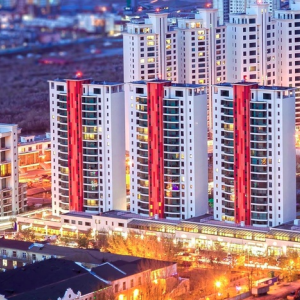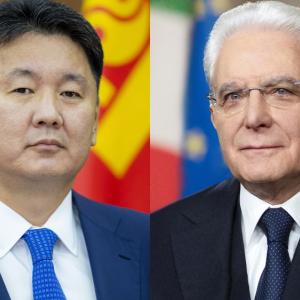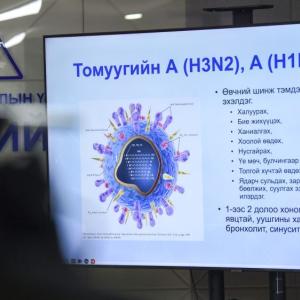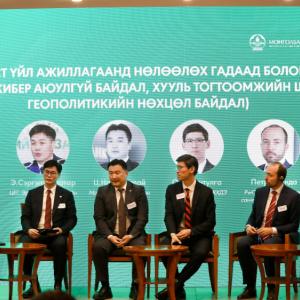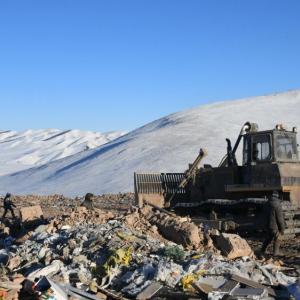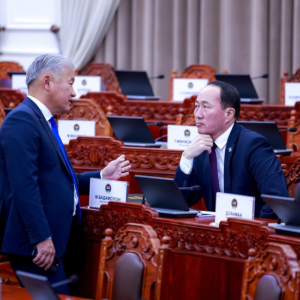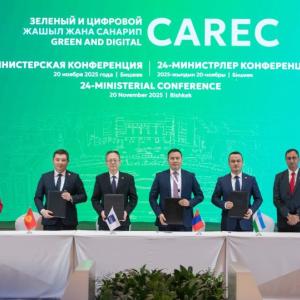“Mongolia can be a role model for the rest of the world for achieving SDGs earlier”
The Mongol Messenger
We interviewed UN
Resident Coordinator for Mongolia Mr. Tapan Mishra on the relations and
cooperation between Mongolia and the United Nations.
The UN established Development Assistance
Framework for 2017-2021 with the Government of Mongolia in 2017. How would you
assess the overall achievements of this?
-As part of its cooperation, the UN adopts a strategic framework document with its member states every 5 years. Currently, the document – United Nations Development Assistance Framework – is being implemented. This document was supposed to be implemented in 2017-2021, but it was extended by one year due to changes in the situation due to the COVID-19 pandemic in the last 2 years. Thus, we evaluated the results and achievements of the targeted activities during the pandemic, and believe that a lot of achievements and successes were achieved during the implementation of the document. However, there are still some areas we need to focus more. Many projects have been implemented and supported at the policy level. I also saw that there is an opportunity to improve certain activities within the framework of reforms and changes that are being carried out under the slogan "One United Nations". Based on the previous achievements and lessons learned, together with the Government of Mongolia, we have signed a document called the Sustainable Development Cooperation Framework (SDCF) for Mongolia for 2023-2027.
What kind of projects and programs are being
implemented within the framework of the cooperation between Mongolia and the
United Nations?
-I would like to first talk about how the SDCF was developed.
First of all, we have analyzed the implementation of the Development Assistance
Framework, which was implemented in the past year in order to support the
targeted activities of the Government of Mongolia, covering a wide range of
social, economic and political aspects. In doing so, we brought together many stakeholders
such as international financial institutions, academia, think-tanks, government
and non-government organizations and civil society to come up with the whole
vision for the next five years of cooperation. As a result, it was agreed that
the strategic document for the next 5 years should be targeted at 4 main pillars
that are aligned to people, prosperity, peace, and planet. It was also
formulated in good coordination with Mongolia’s Vision-2050 long-term
development policy.
Firstly, the cooperation should be based on people and
communities. In other words, the main thing is that it is necessary to focus
more on human development, social development, and strengthening the people’s
capacity. The main content of human development starts with basic human needs
such as health, education, water sanitation, hygiene and security, food availability
and accessibility, and social protection. Ensuring gender equality and
combating gender-based violence have also been prioritized.
Secondly, the planet and prosperity were considered as one of
the four pillars. 23 agencies of the United Nations system will work together
to implement the SDCF, and they have defined how they will support and
cooperate with the government within their respective functions. While making
contributions to the stability of our planet, it contains a specific goal of
reducing greenhouse gas emissions and air pollution, and mitigating the damage
caused by the climate change.
We know that Mongolia's economy is highly dependent on the
mining industry. So, we focused a lot on how to improve and diversify this
economic situation and developed our goals in this regard. It is believed that
by diversifying the current pattern of exporting natural resources and
developing trade, it is possible to make progress in trade cooperation,
especially for Mongolia.
Currently, 85 percent of Mongolia's exports are dependent on raw
materials. It is understood that Mongolia's economy will be diversified by
changing this situation and making more value-added products available to
export.
In addition, there is a need to support Mongolia in creating
certain skills that are required in the labor market in the 21st century.
Looking at the population structure of Mongolia, it is relatively young. Therefore,
in order to take advantage of this opportunity and bring out more of Mongolia's
resources, we intend to bring cooperation closer between the agencies of the
United Nations system, such as International Trade Center, Economic and Social
Commission for Asia and the Pacific, Development Program, and Food and
Agriculture Organization, etc.
Mongolia has a lot of resources for renewable energy, especially
solar and wind energy. It is sunny about 260 out of 365 days a year in Mongolia,
so it is clearly a country with high potential for developing solar renewable
energy. So, if the abundant support is provided, it will play significant role
in reducing Mongolia’s energy dependence. Most importantly, we aim to implement
these development trends in a green, inclusive and accessible manner. As a
landlocked country, Mongolia faces many challenges in transport, logistics and
infrastructure. 85 percent of Mongolia's total exports go to its southern
neighbor. Also, China accounts for 75 percent of Mongolia’s imports.
Mongolia has digitalized about 600 of its government services.
Although Mongolia is a landlocked country, people’s minds are not locked and
the intellectual potential and resources are unlimited. Therefore, we pay
particular attention to supporting the digital development in Mongolia by
introducing innovations and inventions. On September 5-6, the UN Mongolia, in
collaboration with the Ministry of Digital Development and Communications,
organized the first-ever Global Digital Dialogue to exchange experiences
from different countries on how to implement digital transformation strategies
to an audience composed of the Member States, UN entities, private sector,
international financial institutions and other key stakeholders.
The third and final pillar of the document is improving the
people-centered governance, rule of law, and access to justice. It is
formulated that the possibility of providing transparency in governance,
reducing bribery, making services delivered by the government to citizens
accessible and efficient, and developing in an environmentally friendly manner
will be emphasized on this pillar.
Based on all the three pillars, we will work to support the
Government of Mongolia in meeting the demands of the people and fulfilling the obligations
and commitments to achieve the Sustainable Development Goals. Moreover, many
projects and programs will be implemented in line with the SDCF under the
leadership of the government and partnership with the stakeholders.
There is only 8 years left to ensure the
realization of the Sustainable Development Goals. As we all know, the
Government of Mongolia formulated and endorsed the Vision-2050 in 2020. How do you see the coordination between these
two goals?
-In 2015, 192 member countries of the United Nations, including Mongolia, made a commitment to their people and the people around the world to fulfill the SDGs by 2030. Before Vision-2050, in 2016, the Government of Mongolia approved a development policy document until 2030. Thus, in 2020, a longer-term development document, Vision-2050, was approved. This is truly wonderful. Because Vision-2050 is a long-term policy that looks beyond 20 years in addition to the SDGs that must be achieved by 2030. There are only 7 and a half years left now to achieve the SDGs. Due to the short time left, we have evaluated our achievements within the framework of the United Nations Development Assistance Framework document and conducted a very good analysis and research on the state of national development in Mongolia. In this context, what achievements have been made, what lessons and things to learn have been identified very well. As everyone knows, due to the spread of the COVID-19 pandemic, we have faced severe social and economic challenges in the last 2 years, and we have had difficulties in some development levels.
How does the United Nations assess the
implementation of Mongolia's Sustainable Development Goals? Is it possible for
Mongolia to achieve this goal by 2030?
-We are making two main evaluations on the current progress of achieving the SDGs. First, a voluntary assessment at the national level, and secondly, an assessment of what citizens' understanding and opinions are about this. One was carried out in 2019 and the other is planned for 2023. So, after evaluating and assessing all the activities that have been done within the framework of the SDGs, we will have come up with a very clear picture of where Mongolia is going in this goal, whether it is lagging behind, and in which areas we need to support.
On the September 10, we organized an event at the Sukhbaatar
Square to publicize the achievements of the SDGs. In addition to all UN
agencies, all development partner organizations, the Government, ministries,
and other stakeholders in Mongolia were present. We have set up 120 pavilions
in Sukhbaatar square and presented the activities to fulfill 17 SDGs. In addition,
organizations and individuals who made valuable contributions to the
achievement of the SDGs were rewarded. Thus, we discussed the need to speedily
and effectively continue our joint activities and targeted work.
Mongolia is facing many problems due to climate change. One of
the solutions is the "One Billion Trees" national movement initiated
by the President of Mongolia. The adverse effects of climate change and air
pollution are increasing in Mongolia. Desertification is intensifying and land
degradation is occurring. So, the ideal solution to all these problems is the
above initiative. If enough trees can be planted, Mongolia will have a greener
environment. In this way, it is believed that there will be many advantages,
such as reducing the factors that negatively affect the environment, supporting
and sustaining biological diversity, improving fresh water resources, reducing
the extent of desertification, and controlling sand migration.
In general, it is concluded that Mongolia is yielding relatively
well results in terms of SDGs. As we progress further, we intend to create
sustainable development in Mongolia that is focused on human development and
ensures participation without leaving anyone behind.
UN Mongolia and the
Ministry of Digital Development and Communications jointly organized the
first-ever Global Digital Dialogue. What was the key significance and the key
achievements and outcomes of this global dialogue as far as you see?
-The dialogue generally focused on two main points. First, we
focused on how to properly integrate technology to involve all citizens in the
development process. As you all know, more than 600 government services have
been digitalized as part of the digital development policy of the Government of
Mongolia. The organization of the dialogue was a good opportunity for the key
stakeholders to sit together to exchange their opinions and experiences. Thus,
Mongolia was able to be recognized internationally as a leading country that
has made great progress in the world through digital development, innovation
and transition.
During this meeting, it became very clear that all UN agencies
support the achievement of the goals set by the Government of Mongolia. When
considering the program of the conference, we organized sessions for in-depth
evaluation of the issues within the framework of the five main themes. The
first key session focused on the theme of "Digital for Green" and was
directed by the Food and Agriculture Organization of the United Nations. The
second session of the dialogue touched on the topic "Digital transformation
as an enabler to sustainable economic transformation and recovery." The
third key session is about how to move forward without leaving anyone out and
ensuring the participation of every citizen within the framework of this digital
innovation and transformation. And the fourth session was on how to integrate
modern technology to diversify and develop the economy. Within the fifth and
the final session, we talked about how to develop digital development in a
greener way. Thus, we made the progress of Mongolia known to the international
community and shared our accumulated best experience and new ideas.
Representatives of India, Bangladesh, Korea and Japan
participated in it. Also, the representatives of Singapore and Estonia, who
introduced technology in the framework of governance very efficiently,
rationally and successfully, shared their best practices. The most important
objective of the dialogue was to learn from each other and come up with
rational solutions. Thus, we were able to prove that Mongolia is one of the
leading countries that is successfully working in the field of digital
innovation and transformation on the international stage.
UN Secretary General
Antonio Guterres visited Mongolia on August 8-11. What was the key results of
this visit?
-The UN Secretary-General usually pays visit to countries that
are in great crisis or that are considered essential to visit. We all know that
Mongolia is not a country affected by a major crisis However, the UN Secretary-General's visit to
Mongolia is a sign that the UN attaches great importance to Mongolia.
He repeatedly emphasized Mongolia's contribution to peace. Most
importantly, the Secretary-General paid a visit to Mongolia to emphasize the
important contribution of Mongolia to the international community in the
framework of non-proliferation of nuclear weapons.
He highly praises Mongolia in two ways. Firstly, Mongolia has
declared itself as a nuclear-weapon-free zone internationally, which greatly
contributes to achieving the goals set by the UN and its member states in the
direction of non-proliferation of nuclear weapons. Secondly, the
Secretary-General’s visit was a token of his gratitude in recognition of
Mongolia’s valuable contribution to establishing peace and security in the in
the region. Of course, on the other hand, it was commended that Mongolia is
making a good progress towards achieving the SDGs.
Another important thing that the Secretary General of the United
Nations gave high importance to and emphasized favorably is that Mongolia
organized the "Ulaanbaatar Dialogue" for many years in order to
contribute to the security of Northeast Asia.
Mongolia also organized a major conference supporting female
peacekeepers within the framework of the goal of promoting world peace and
security. It was highlighted that this is an important contribution of Mongolia
to establishing world peace. It was also emphasized that the United Nations in
Mongolia and the Government of Mongolia are working together with all partner
organizations to achieve the Sustainable Development Goals and are making
progress towards the Sustainable Development Goals.
Is there anything you
would like to say to the readers to end this interview?
- I would like to express that the UN Mongolia is committed to supporting the Government of Mongolia and the people of Mongolia and will fully cooperate with them in fulfilling their obligations and commitments towards achieving the SDGs.
The participation of every citizen in achieving the SDGs is very important. I would also like to urge all Mongolians to make contributions such as by saving energy, planting trees, recycling waste, etc. With the active engagement of the people, we can show the world that the SDGs can be achieved earlier.
 Ulaanbaatar
Ulaanbaatar





































